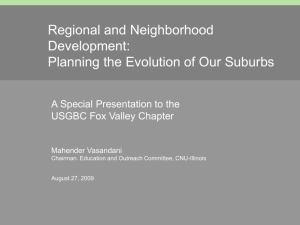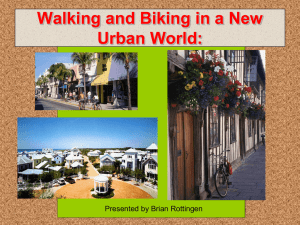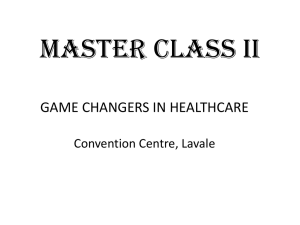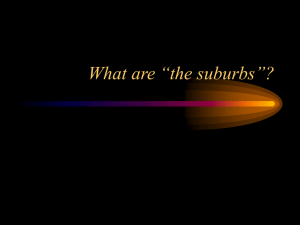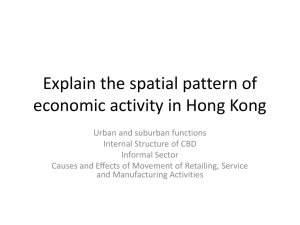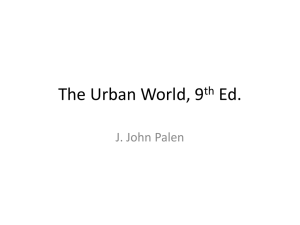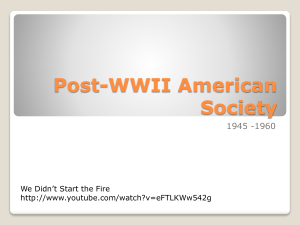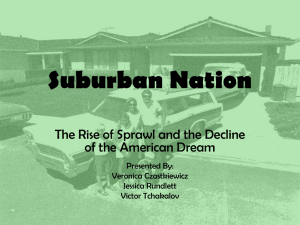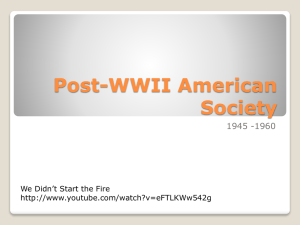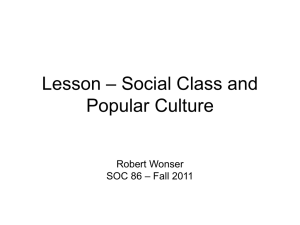PowerPoint presentation - American Planning Association
advertisement
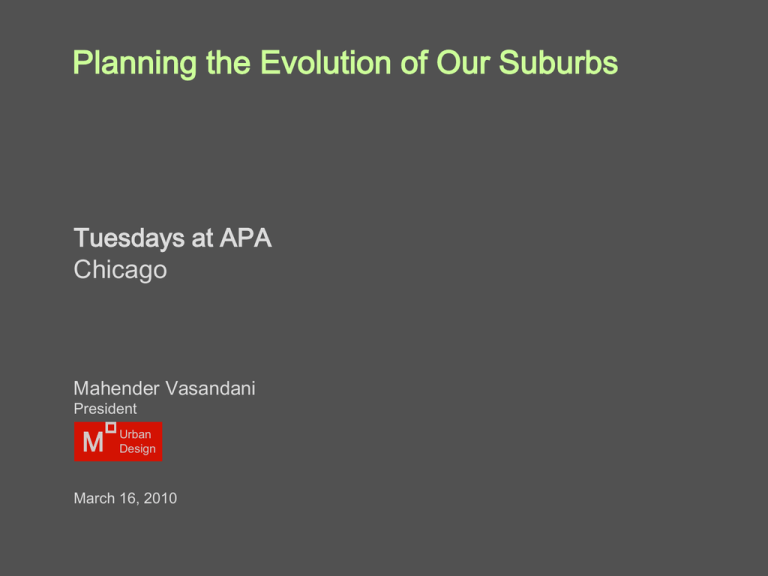
Planning the Evolution of Our Suburbs Tuesdays at APA Chicago Mahender Vasandani President M Urban Design March 16, 2010 What I Will Talk About: Where Are We Today in Terms of Regional Growth? The Implications of the “Big Challenges” for the Suburbs Why the Suburbs May Need to Evolve? Any Preferred Growth Options? What Can We Learn from the Cities? New Urbanism Offers Some Key Answers • Specific NU Examples Suitable For Suburbs • Overview of Form-Based Codes Can the Suburbs Stop Resisting Change? Q&A 2 M Urban Design Chicago’s Outlying Suburbs 3 M Urban Design Where Are We Today? Acknowledgement: Ours Is A Suburban Nation From 1950 to 2000: 90% of metropolitan growth in the Suburbs By 2000: 60% of metro jobs in the Suburbs Suburb-to-Suburb job commutes 2X Suburb-City commutes From 1970 to 2000: Total Housing Units Increased 9% Suburban Housing Units Increased Almost 100% Question: Is This All Good or All Bad? Is this growth pattern sustainable? 4 M Urban Design Implications for the Future Response Depends on One’s Perspective on the Age-Old Debate: http://www.latimes.com/news/printedition/opinion/la-op-kotkin6-2008jul06,0,1038461.story The “Leinbergers” vs. The “Kotkins” City living is good/better Suburban living is good/better Living + working in City is the only way forward; More sustainable Living closer to suburban jobs keeps travel miles low Multiple transportation modes and route options Car-dependent travel; limited route options A mix of uses within walking distance Single, isolated uses force car travel for all needs Less car use = Less pollution More car use = More pollution; More congestion Many suburbs will not survive Suburban demand will remain strong 5 M Urban Design For Their Survival, Suburbs Will Need to Evolve 1. Economic Challenges: Housing Over-Supply Commercial Oversupply Implications: Limited/Slow Short-term Growth Potential; Extended Growth Time-lines 2. Energy Security/Climate-Change Challenges: Over-dependence on high-carbon fossil fuels/GHG Emissions Over-dependence on cars as sole form of mobility Implications/Policy Questions: ”Re-Order” Growth Patterns? Reduce Total Car Travel? New Mobility Technologies? 3. Urban Form Challenges: Sprawling growth patterns energy-intensive Community character issues Implications: Better Urban From and Character Necessary 6 M Urban Design “Re-Order” Regional Growth Patterns (Climate and Urban Form Challenges) Chicago Metro: Over 100 Years of Growth Past growth => Slow Future Evolution Past Recommendations: Create Growth Boundaries/ Stop Suburbanization • Limit Infrastructure Spending • No real BOLD planning considerations (notwithstanding the legacy) • “Re-ordering” Virtually Impossible for Historical / Political Reasons Source: 2010 Benefits Time-Scale 2020 2030 New Regional Policies Necessary Most New Strategies Possible at Local Level – If Suburbs Take the Challenge 7 2040 M Urban Design Reduce Total Vehicle Miles Traveled (Climate and Urban Form Challenges) Regional Policies 1. 2. Reduce Total Miles of Travel • Trip-length shortening not as beneficial as cutting down on number of trips - Joe Cortright, Impresa Consulting for “CEOs for Cities” • California SB 375 Example (did not include VMT reduction as a goal) Extend Transit Service to Outlying Suburban Communities Local Strategies 1. 2. 3. 4. 5. Encourage Higher Density Living Encourage Live-Work Units Encourage People to Live Close to Work Build TODs Avoid Car Trips 2010 Benefits Time-Scale 2020 2030 8 2040 M Urban Design New Mobility Technology Considerations New Alternative Fuels; Zero-Emission Vehicle Technologies ”Since VMT are not projected to decrease significantly in the near or long-term in the Chicago region, CMAP’s strategies to promote alternative fuels are important to help save energy and mitigate GHG and other pollutants” – Volpe Center, U.S. DOT -- October 2008 Action Strategy Paper on Climate Change and Energy My Crystal Ball ?! In Another Generation: 1. NMT use wide-spread 2. NMT Evolution (in recent times)! 3. 4. 5. 6. 7. Less serious concern with GHG emissions/pollution?? Little change in locational decisions More cars on limited capacity roads More Traffic Congestion More Need For Walkable Mixed-use Communities With Transit Options: WHY Local Strategies Will Matter Toyota FCHV in 2015 “Shockingly Low Price” Honda FCX Clarity: 2009 2010 Benefits Time-Scale -Toyota Motors www.autobloggreen.com July 20, 2009 article 2020 2030 9 2040 M Urban Design Local Strategies: Suburban Evolution with New Urbanism New Urbanism: A 20+ year old Planning and Urban Design Discipline NU learns from the virtues of existing and past cities. NU helps create: Compact, Connected, Walkable, Diverse Neighborhoods with Mixed-Uses Quality Public Realm and High Quality of Life Distinct Transportation Solutions New Codes and Tools for Implementation Examples from City of Chicago: Neighborhoods and Boulevards 10 M Urban Design NU Principles for Suburban Neighborhoods (Local Strategies) Create Inter-connected Street Networks Between Neighborhoods Create Neighborhoods with Mixed-Uses Centers within Walking Distance of Most Residents Locate Neighborhood Centers with Exposure and Access to Major Arterials Allow A Variety of Residential Types Allow Moderately High Densities Focus on Urban Design along with Land-use, Transportation, Finances and Services Create Hierarchy of Streets/Reflected in Urban From Create Quality Places Evolve as a Suburban Community…Become More Urban – “New Urban” 11 M Urban Design NU Principles for Roadway and Context Design (Local Strategies) Adopt not just a tax-revenue-based land-use and transportation policy… But an “Urban Design Policy” to allow roadway hierarchy (Boulevards for example) with multiple transportation choices (GREEN TRAMWAYS!), mixed-uses and multiple residential types 12 M Urban Design NU Design Principles (Local Strategies) For better traffic circulation and less traffic congestion, avoid/minimize cul-de-sacs and dead-end streets as they promote greater car dependence Instead, allow well-connected network of streets that may or may not be rectilinear 13 M Urban Design Suburban Evolution with New Urbanism: Suburban Mixed-Use Community Harbor Town, Memphis, TN: Variety of Residential Types Mixed-Uses; Walkable and Connected Neighborhoods; Boulevard System; Strong Sense of Place 14 M Urban Design Suburban Evolution with New Urbanism: Suburban Community + Town Center New Town at St. Charles, MO: Innovative Variety of Residential Types; Mixed-Use Center/Civic Center; Integrated/Creative Stormwater System; High-quality Public Realm/Sense of Place 15 M Urban Design Suburban Evolution with New Urbanism: New Suburban Downtown Legacy Center, Plano, Texas Town Center on street grid; Commercial, Office, Hotel, Restaurants Townhomes, Condominiums/Apartments; Central Civic Space Sense of Place 16 M Urban Design Suburban Evolution with New Urbanism: Residential + Mixed-Use TOD Addison Circle, Addison, Texas: Close to suburban train station Primarily Residential with Townhomes and Apartments; Major Open Space Central to Plan Moderately High Density; High Quality of Space/Strong Sense of Place 17 M Urban Design Suburban Evolution with New Urbanism: Community Shopping + City Hall Southlake Center, Southlake, Texas: Central Civic Space: Foreground to Village Hall Surrounded by Mixed-Use Shopping + Offices, Entertainment, Restaurants and Townhomes Major Innovation from Single-Use Shopping Center (as initially proposed) Highly Successful Community Destination/Community Pride 18 M Urban Design Suburban Evolution with New Urbanism: Residential + Mixed-Use TOD Plano TOD, Texas: New downtown/TOD at a DART station Moderately dense Neighborhoods with Mixed-Use Shopping Economic Development/Transit Ridership Increase/Sustainable Model 19 M Urban Design Incidentally, Public Demand for Transit * 1 2 Improve Public Transportation: 31% 47% Not Sure: 8% 50% Expand/ Improve Roads: Not Sure: 16% 3% Not Sure: Build New Roads: 20% 5% 3 20% 25% Improve Transit: Maintain/ Repair Existing Roads, Highways, Bridges: Build highways and freeways: Build Walkable Communities: Survey Questions*: 1. Transportation Priorities of Federal Government 2. Best Long-Term Solutions to Reduce Congestion 3. Transportation Approach to Accommodate Growth Build commuter rail, light rail and subways: *January 2009 Growth and Transportation Survey by Hart Assoc. As reported in “Common Ground” Summer 2009, Published by National Association of Realtors 75% 20 M Urban Design Also…Federal Livable Communities Act (Local Strategies Support) August 6, 2009: Senator Christopher Dodd introduced a new Livable Communities Act that should help communities: > > > > > > Mitigate traffic congestion Reduce greenhouse gas emissions Cut down on fuel consumption Protect open space Build affordable housing Revitalize existing main streets and urban centers The new Livable Communities Act Provisions: Create competitive planning GRANTS to establish long-term plans Create challenge GRANTS to implement the long-term plans Establish a Federal Office of Sustainable Housing and Communities at the HUD Establish a Federal Interagency Council on Sustainable Communities to coordinate federal sustainable development policies and programs 21 M Urban Design New Urbanism Implementation Tools: Form-Based Codes 1. Relatively New Regulation Tool in Illinois 2. Based on A Community Vision 3. Focus: Public Realm (Form and Quality of the Built Environment) 4. Place-specific to Retain/Create Character 5. Several Urban Standards 6. Graphic/More Comprehensible 7. Predictable Urban Form and Character 8. Different from Conventional Zoning Regulations FBCs more concerned with Urban Form, Less with Use FBCs facilitate mixing of uses Not concerned with F.A.R.s, Densities and Lot Coverages Allow administrative approval of projects 22 M Urban Design Form-Based Codes/Regulations Focus on the Quality of Public Realm Public Realm: Influenced by buildings architecture; the proportions of the size of public space to building height, and the amenities and materials in the public space Project Credit: Dover Kohl & Partners 23 M Urban Design Form-Based Codes/Regulations Predictable Placement and Bulk of Buildings • Predictable massing and bulk of future projects • Benefits: Less public concern about bulk and other impacts Streamlined project review process Good for developers too Project Credit: Dover Kohl & Partners 24 M Urban Design Form-Based Codes/Regulations An Integrated Code with Standards for: Thoroughfares, Frontages, Building Types, Public Spaces, Landscaping – All Linked to a Regulating Plan Typically Easier to Comprehend and Administer 25 M Urban Design Form-Based Codes/Regulations Conventional/Euclidian FBCs Based on Abstract Land Use and Based on Adopted Community Vision Zoning Categories Segregated/Isolated Uses Mixed Uses Proscribes (What Is Not Allowed) Prescribe (What Is Desirable) Unpredictable Building Bulk/Form Predictable Building/Urban Form (F.A.R.s and Densities by Lot Size) Unpredictable Character (Bulk Limits regardless of Lot Size ) Vision of Built Form Predetermined Site Development Capacity Analyses; Retain existing or create new character Rarely Any Sense of Place/Form-less Power of Place/Strong Urban Form 26 M Urban Design Local Strategies for Suburban Communities Allow mixing of uses Allow diversity of housing options/housing types Allow moderately higher densities Allow street connectivity Allow multi-functional streets/boulevards Create compact and walkable neighborhoods Create great places (Summary) Altogether…Become More Urban: “New Urban” 27 M Urban Design Can the Suburbs Stop Resisting Change? Stop Regarding Density as an Issue > Allow Creative Density for Making Better Communities Stop Isolating Land Uses in Single Pods > Allow Creative Mix of Land Uses Stop Treating Roadways as Only Transportation Routes > Allow Hierarchy of Roadways to Create Places Stop Maximizing Revenues by Maximizing Commercial Uses > Allow Residential or Mixed-Uses Along Arterials Stop Resisting Change > Become More Urban 28 M Urban Design Closing Remarks Future of Suburbs • • Must Evolve Given Economic, Energy and Climate Challenges Evolution Will be Essential for Survival/Revival New Urbanism Offers Key Answers for Suburban Evolution • • • NU Principles Should be Part of Local Strategies and Policies Quality Places and Quality of Life Will Make Better Communities NU Provides Effective Tools for Implementation and Evolution 29 M Urban Design Thank You! Mahender Vasandani President M Urban Design M Square | Urban Design 0N262 Armstrong Geneva, Illinois 60134 T: 630.845.1202 F: 630.444.1852 C: 630.853.0733 mgv@msqre.com www.msqre.com 30
